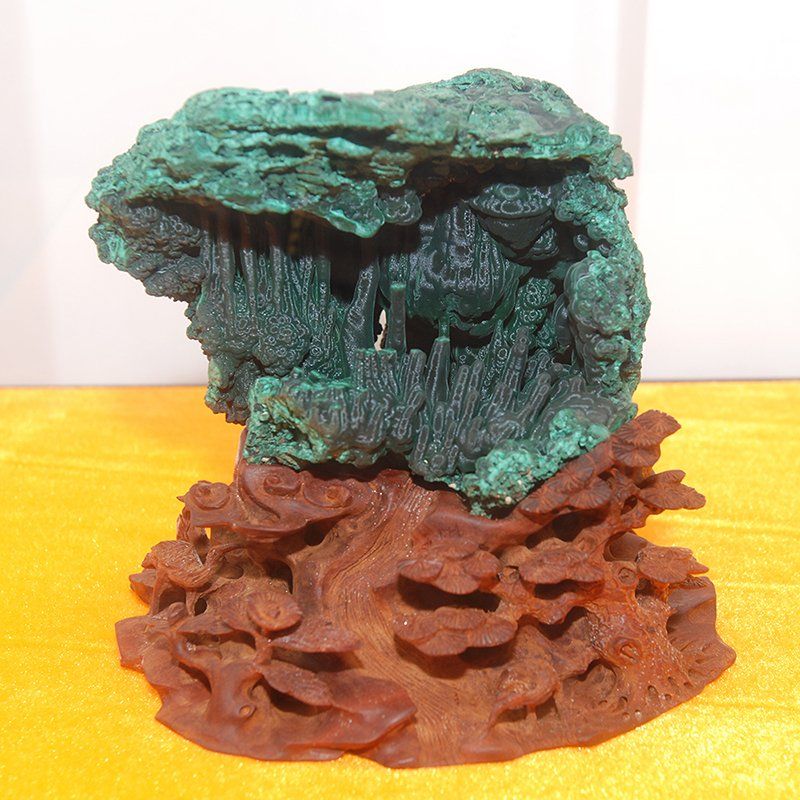Malachite or Peacock Stones
Overview of Malachite used as Viewing Stones
By Thomas S. Elias, March, 2012
Malachite from Yangchun mine in Guangdong Province
Historical Aspects: Malachite is intimately woven with the history of China because of the role that copper played in the development of the Bronze age in that country. Bronze, a copper and tin alloy, was known in China perhaps as many as 3,000 years ago. Malachite was certainly encountered very early as cooper ore was gathered. Malachite is a versatile mineral that was appreciated for its use in medicine, a source of pigments, and for its natural beauty. Many of the shades of green pigments used in paintings came from finely ground powdered malachite. Du Wan, a 12th century rock connoisseur, produced the first catalog of stones prized for their natural beauty, and in this work, Du described 114 stones with malachite as stone number 83 (Schafer, 1961). Hay (1985) illustrated several small stones which became known as accoutrements for the Chinese scholar’s table including a reniform malachite mountain stone. Mowry (1997) illustrated and commented on a piece of Qing dynasty malachite, while three malachite stones were illustrated in Hu’s (1998) book The Spirit of Gongshi: Chinese Scholar Rocks.
Origin: The earliest pieces of malachite likely came from the Huangshi District in Hubei province, an ancient and important copper producing area of China. Deposits were also found in copper-producing areas in Guangdong, Anhui, and Jiangxi provinces. Later copper ore and its associated malachite and azurite have been discovered in Yunnan and Xinjiang Provinces and in Inner Mongolia. Malachite is formed in limestone rocks containing copper and, when conditions exist, oxygen-rich water seeps into cracks and crevices and comes into contact with the copper ores. Over long periods of time, the copper ore is weathered and may be altered to form azurite and then malachite. Thus, it is known as a secondary copper mineral. Azurite with its typical bluish color is found with the characteristic green malachite. Malachite is frequently deposited in concentric layers in masses. These may be clusters of botryoidal (grape-like) shaped formations, or form stalactites, and even velvety fibrous masses. There are numerous variations to these formations as well as varying shades of green from light to very dark. Every piece is unique. Malachite is relatively soft registering 3.5 to 4 on the MOH scale. It is an immensely popular mineral for use as jewelry and as decorative stones.
Fiberous malachite
Features: The features of a stone depend largely upon the mine or open pit where it originated from. For example, nice botryoidal stones have been produced at the Daye Verdigris Hill Mine in Hubei province while more grainy and velvety masses were found in the Shilu mine pit in Yangchun. The presence of large masses of malachite were dependent upon geological features at each site and, then the methods of ore extraction was a major factor in gathering large, undamaged pieces of malachite before it was broken into small pieces and/or process with the copper ore to obtain copper. Different features contribute to a stones value. Small beautifully formed stalactites, masses with caverns or cave-like features, multi-green colors, and mountain-shaped stones are all highly desirable. Size is important too. Large attractive stones, ranging in size from 15 to 50 cm high, wide and deep, sell for one to several thousand dollars. High quality, large malachite stones are rare and expensive; however, small pieces ranging in size from a ping pong ball to a softball can be seen in stone markets at moderate prices, especially in southern and southwestern China.
Before investing in malachite, it is recommended that perspective buyers examine many examples and different types of malachite and compare prices. The best buys and greatest selection of malachite occurs in the cities where the mines or open pits are located; however, these are not on the typical tourist routes. Malachite when polished makes strikingly beautiful stones that are often sought after by mineral collectors. However, aficionados of viewing stones prefer overwhelmingly only natural, unpolished stones with their normally irregular shapes. Quality Chinese malachite is in short supply and large collector’s pieces are scarce and expensive. Currently, large quantities of African malachite is being imported to China and sold on the wholesale market to stone dealers who, in turn, sell it at the retail stone markets in China. It is difficult to distinguish Chinese malachite from African specimens; thus deal with reputable dealers who will tell buyers if the malachite originated in China or Africa. African malachite is more abundant and slightly less expensive.
References in Chinese: Du Wan (Chen Yunyi, translator), 2009; Huang, 2004; Liu, 2007, pp.292-297; Zhang Y & Huang X., eds., 2007.
References in English: Little 1999, p. 26; Hay 1985, p. 69; Hu 1998, pp. 53, 67, 108; Schafer 1961, 23-25, 86.



